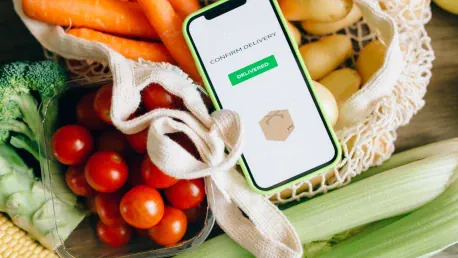What if grocery shopping didn’t mean navigating crowded aisles or waiting in long queues? In Australia, grocery apps are revolutionizing how people shop, offering the convenience of having essentials delivered right to their doorsteps with just a few taps. This shift presents a lucrative opportunity for businesses to connect with digitally-savvy consumers while gaining advantages like streamlined processes, improved sales, and stronger customer relationships. But before diving into this promising market, one key question remains—how much does it cost to build a grocery app in Australia? Let’s uncover the answer.
The cost to build a grocery app like Coles typically ranges between AUD 40,000 and AUD 300,000, depending on the app’s complexity, features, platform, and design. Elements like integrating advanced features, ensuring a seamless user experience, and maintaining robust security standards significantly influence the budget. So, how can you build a grocery app that stands out in the Australian market? Let’s explore this journey in detail.
Conduct Market Research and Analyze Target Audience
Understanding the grocery delivery market size and analyzing competitors like Coles are crucial steps in developing a successful grocery app. By conducting thorough market research, businesses can identify trends, demands, and potential gaps in the market. Analyzing competitors will help you understand their strengths and weaknesses, enabling you to create a superior product. Additionally, identifying users’ pain points is essential to ensure your app addresses their needs effectively. For instance, consumers may seek features such as seamless navigation, personalized recommendations, or flexible delivery options.
Conducting surveys or interviews with potential users can provide real-world insights, which can shape the unique value proposition of your app. By gathering this data, you can tailor your grocery app to meet the specific demands of the market, thereby increasing its chances of success. Understanding your target audience also helps in designing user-friendly interfaces and incorporating features that enhance user satisfaction. The insights gained from market research and target audience analysis will provide a solid foundation for developing a grocery app that not only meets but exceeds user expectations.
Define App Features and Functionalities
Listing essential features like product search, online payments, delivery tracking, loyalty programs, and push notifications is the next step in the development process. These features provide value to users and enhance their shopping experience, making them more likely to use your app regularly. Ensuring these features are user-friendly and efficient is crucial for the app’s success. For example, integrating a powerful search engine that allows users to find products quickly and easily can significantly improve user satisfaction.
Additionally, considering advanced options like voice search or AI-driven product recommendations can set your app apart from competitors. Voice search functionality enables users to find products without typing, while AI-driven recommendations provide personalized shopping suggestions based on user behavior. Incorporating such advanced features can enhance the user experience and increase engagement. However, it’s important to balance these features with the overall development budget and timeline to ensure that the project remains feasible and within scope.
Select the Appropriate Technology Stack
Choosing a robust technology stack, including frontend, backend, and database frameworks, is a critical step in the app development process. The technology stack determines the app’s performance, scalability, and security. Using cross-platform development tools like Flutter or React Native can save time and costs by allowing developers to write code that works on both iOS and Android platforms. Secure payment gateways like Stripe or PayPal ensure that users can make transactions safely and reliably.
Incorporating cloud solutions like AWS or Google Cloud ensures scalability, enabling the app to handle a growing number of users without compromising performance. A well-chosen technology stack not only improves the app’s functionality but also ensures that it can adapt to future technological advancements. It’s essential to work with experienced developers who can recommend the best technologies for your specific needs, ensuring a seamless and efficient development process.
Design UI/UX and Create Prototypes
Developing an intuitive and user-friendly design with a clean interface is essential for the success of your grocery app. A well-designed UI/UX ensures that users can navigate the app effortlessly, find products quickly, and complete transactions smoothly. Focus on creating visually appealing product catalogs and an easy checkout process to enhance the overall shopping experience. Using wireframes and interactive prototypes can help visualize the user journey and gather valuable feedback before finalizing the design.
Involving potential users in the design process through usability testing can provide insights into their preferences and pain points. This feedback can be used to refine the design and ensure that the app meets user expectations. Prioritizing accessibility features, such as voice navigation and screen reader compatibility, ensures that a wider audience can use the app comfortably. By investing time and effort into designing a user-centric UI/UX, you can create an app that stands out in the competitive grocery delivery market.
Develop the Minimum Viable Product (MVP)
Starting with a Minimum Viable Product (MVP) that includes core features like user registration, product catalog, and checkout is a strategic approach to app development. Launching the app with basic functionality allows you to gather feedback from early users and refine the product based on their input. This approach minimizes initial development costs and helps validate your idea in the market before investing in more advanced features.
An MVP also provides an opportunity to test the app’s performance, identify any issues, and make necessary improvements. By focusing on core functionalities that meet user needs and testing market demand, you can ensure a smooth and successful launch. Setting a clear roadmap for future enhancements based on initial MVP success is crucial for long-term growth and scalability. This iterative approach allows you to make informed decisions and optimize the app’s features and performance over time.
Build Backend and Integrate Systems
Creating a scalable and secure backend to handle large user data is essential for the smooth functioning of a grocery app. The backend should support real-time inventory management, payment processing, and delivery tracking to ensure seamless operations. Integrating APIs for these functionalities allows for efficient data exchange between the app and external systems.
Incorporating encryption protocols and authentication systems is crucial to protect user data and ensure compliance with industry standards and regulations. A robust backend infrastructure not only enhances the app’s performance but also provides the flexibility to add new features as the app grows. Working with experienced developers who understand the intricacies of backend development can help build a reliable and secure system that supports your app’s functionality and scalability.
Perform Testing and Quality Assurance
Conducting rigorous testing to identify and fix bugs or glitches is a critical step in ensuring the app’s success. Testing the app for performance, security, usability, and compatibility across various devices and operating systems is essential to provide a flawless user experience. Involving beta testers to simulate real-world scenarios and gather feedback can help identify potential issues and areas for improvement.
Quality assurance processes should include both manual and automated testing to ensure comprehensive coverage. Regular testing and updates are necessary to maintain the app’s performance and address any new issues that may arise. By investing in thorough testing and quality assurance, you can launch a reliable and high-performing app that meets user expectations and stands out in the competitive market.
Launch and Maintain the App Post-Launch
Deploying the app on app stores with optimized descriptions and visuals is the final step before reaching your audience. A well-executed launch strategy can significantly impact the app’s visibility and user adoption. Providing regular updates, monitoring user feedback, and continuously improving the app are crucial for maintaining user satisfaction and staying competitive.
Investing in marketing strategies like in-app promotions, social media campaigns, and SEO optimization can increase app engagement and retention. Collaborating with influencers or running paid ads can also help attract new users. Post-launch maintenance involves monitoring the app’s performance, addressing any issues promptly, and introducing new features based on user feedback and market trends. By focusing on user satisfaction and continuous improvement, you can ensure the long-term success of your grocery app.









